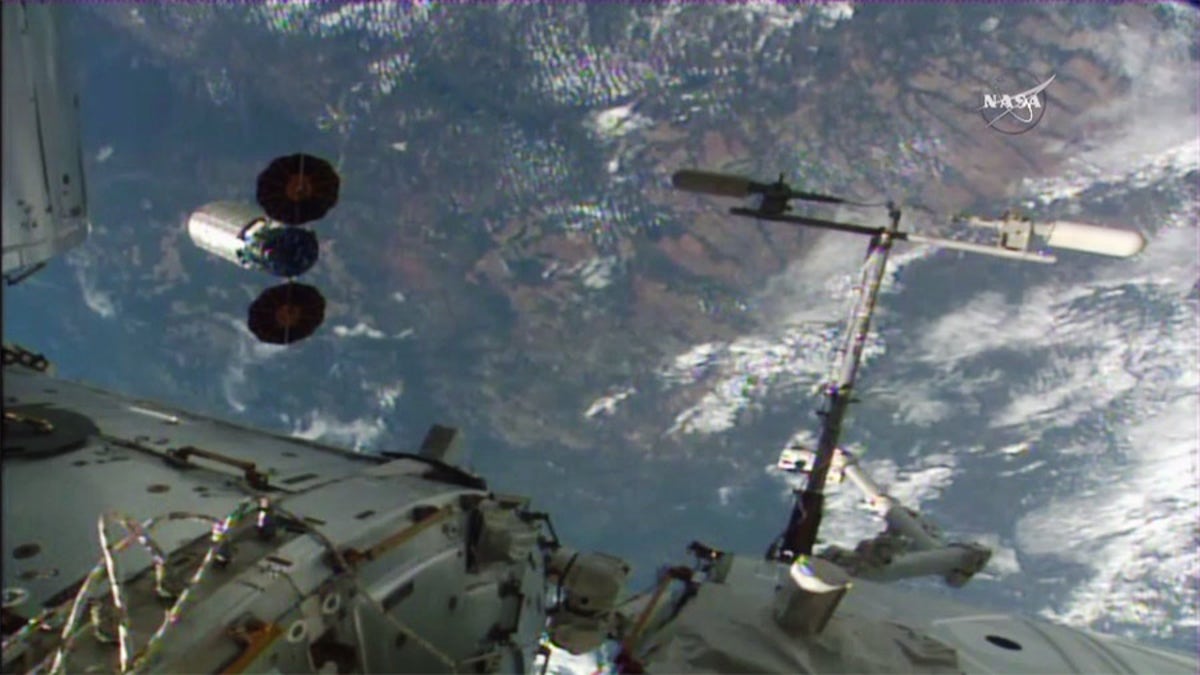
The Orbital ATK Cygnus spacecraft S.S. Rick Husband departs the International Space Station on June 14, 2016 to end its delivery mission. NASA will light the largest fire ever set in space inside the spacecraft in an expe (NASA TV)
A private cargo ship left the International Space Station June 14 and will soon host the biggest fire-in-space experiment ever conducted.
The robotic Cygnus spacecraft, which was built by Virginia-based company Orbital ATK, undocked from the orbiting lab at 9:30 a.m. EDT. At about 2:30 p.m. EDT, when the freighter is a safe distance from the ISS, controllers on the ground will deliberately light a large fire inside Cygnus to test how flames spread in microgravity. (If you missed the undocking, don't fret. You can watch our timelapse video of Cygnus' space departure here.)
The fire experiment — called the Spacecraft Fire Experiment-1, or Saffire-1— will spark the biggest human-made fire in space. The investigation will gather information that should help protect astronauts on long-duration missions, because fire is deemed one of the top risks for disabling a spacecraft or a space station, NASA officials have said. [Experiment Will Light Largest Fire in Space (Video)]
In the 1990s, Russia's Mir space station was crippled when a malfunctioning oxygen candle sparked a fire. While the crew on board ultimately controlled the fire and escaped unharmed, they were hindered by faulty oxygen masks and other problems.
But testing fire's spread for safety's sake is difficult when astronauts are nearby, NASA officials said, and this led to the idea for Saffire-1. This is the first time such an experiment will run, and two other iterations are planned.
"Saffire seeks to answer two questions," principal investigator David Urban said in a statement issued in March. "Will an upward-spreading flame continue to grow, or will microgravity limit the size? Secondly, what fabrics and materials will catch fire, and how will they burn?"
Saffire-1 will take place inside a 3-by-5 foot module that has two compartments in it. One side has the materials needed to create a fire, while the other contains instruments to record the fire, such as sensors, high-definition video cameras and signal-processing equipment.
Saffire-1 (and Saffire-3) will each burn a large, 16-by-37-inch fiberglass and cotton cloth, known as a SIBAL cloth. The material has been tested before with smaller-scale fires in space. The cloth will first be ignited from the bottom, and if it burns out, engineers will also light it from the top to see how the flame spreads against the airflow, NASA officials said.
The next iteration of the experiment, Saffire-2, will set alight materials used commonly in space, such as those used in Plexiglas windows, astronaut clothes and storage facilities. These materials are intended to be flame-retardant. The samples used will be 2 by 11 inches, which is the same size NASA uses to test materials on Earth for space safety.
On June 15, Cygnus' handlers will also deploy five small cubesats from the cargo ship, which had been docked to the space station since March 26. The tiny spacecraft will help track ships at sea and monitor weather, NASA officials said.
The freighter will meet its planned doom June 22 by burning up in Earth's atmosphere, while carrying 3,000 lbs. of trash.
Originally published on Space.com.




















